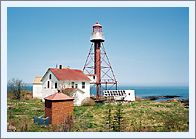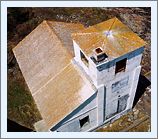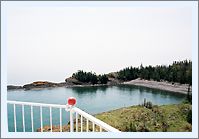|
Historical Information

Three miles in length and 1¼ miles
at its widest point, Manitou Island sits approximately 2¾ miles to the
east of Keweenaw Point at the northern end of the Keweenaw Peninsula.
Serving as the marker for an important turning point for both up and
down-bound vessels, as well as those making south toward Marquette and
Houghton, rocky shoals extended from the island's shores in all
directions, representing a significant threat to any captain passing too
close to the island during periods of limited visibility.
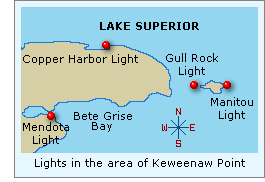 With
construction of the new lock at the Soo planned for completion in 1855,
a major boom in maritime commerce on Lake Superior was both expected and
eagerly anticipated, and a light on Manitou thus became of critical
importance to mariners. To this end the first station on Manitou Island
was built at the eastern end of the island in 1849 at a cost of $7,500.
While no known images of this station exist, we do know that it
consisted of a 60 foot tall rubble-stone tower outfitted with a Lewis
Lamp array at a focal plane of 71 feet. Angus M Smith received the
appointment as the stations first keeper, and moved into the simple
attached rubble stone dwelling on September 5, 1849, exhibiting the
light for the first time soon thereafter. With
construction of the new lock at the Soo planned for completion in 1855,
a major boom in maritime commerce on Lake Superior was both expected and
eagerly anticipated, and a light on Manitou thus became of critical
importance to mariners. To this end the first station on Manitou Island
was built at the eastern end of the island in 1849 at a cost of $7,500.
While no known images of this station exist, we do know that it
consisted of a 60 foot tall rubble-stone tower outfitted with a Lewis
Lamp array at a focal plane of 71 feet. Angus M Smith received the
appointment as the stations first keeper, and moved into the simple
attached rubble stone dwelling on September 5, 1849, exhibiting the
light for the first time soon thereafter.
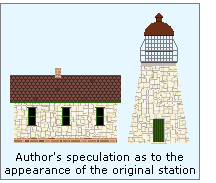 On July 29 of the following year, Henry
B. Miller, the district Superintendent of Lights, accompanied the
contractor to inspect the new station, reporting that "Everything
here is in good order. The tower is, in my opinion, a good one, and is
all complete, with the exception of the spindle or lamp frame in the
tower, which is missing." The contractor pledged to install the
missing frame, and Miller signed-off on the project as complete and
satisfactory. While rapid deterioration of the structure over the
ensuing ten years indicates that Miller likely overlooked some serious
construction flaws, he was evidently aware of the isolated existence
keeper Smith was forced to endure, since in his report for that year
Miller recommended that the pay for a couple of keepers at less isolated
stations in the district be reduced, in order to allow a fifty dollar
increase in Smith's annual pay rate. On July 29 of the following year, Henry
B. Miller, the district Superintendent of Lights, accompanied the
contractor to inspect the new station, reporting that "Everything
here is in good order. The tower is, in my opinion, a good one, and is
all complete, with the exception of the spindle or lamp frame in the
tower, which is missing." The contractor pledged to install the
missing frame, and Miller signed-off on the project as complete and
satisfactory. While rapid deterioration of the structure over the
ensuing ten years indicates that Miller likely overlooked some serious
construction flaws, he was evidently aware of the isolated existence
keeper Smith was forced to endure, since in his report for that year
Miller recommended that the pay for a couple of keepers at less isolated
stations in the district be reduced, in order to allow a fifty dollar
increase in Smith's annual pay rate.
At the dawning of the decade, the
maritime community rose in anger at the dismally poor administration of
the nation's aids to navigation by the Fifth Auditor of the Treasury.
Congress reacted in 1852 by forming the Lighthouse Board, to which it
simultaneously transferred responsibility for the management of all
lighthouses. Made up of individuals with maritime and engineering
experience, one of the Board's first priorities was to undertake a
system-wide upgrading of illumination technology, switching over from
the universally adopted Lewis Lamp to the vastly superior French Fresnel
lenses. To this end, a work crew arrived at Manitou in 1856 to supervise
the replacement of the station's birdcage lantern with a modern
octagonal structure of cast iron, into which the District Lampist
carefully installed a flashing white Fourth Order Fresnel lens, thereby
increasing the station's visibility range to 14 miles in clear weather.
In 1855, Smith identified an additional
method through which he was able to increase his income, by having his
wife Lydia appointed as the station's assistant, a tactic repeated by
three following keepers! By 1859 the condition of the Manitou
Island station had deteriorated so far as to prompt Michigan Senator
Zachariah Chandler to raise the urgent need for repairs or replacement
in the Senate on February 10. In order to obtain a better understanding
of the issue, the matter was forwarded to the Department on Commerce
with instructions to investigate and to return with a recommended course
of action. Evidently the investigation proved positive, since the
necessary appropriation was made, and the Eleventh District Engineer
drew up plans for the construction of three virtually identical
structures at Manitou, Whitefish Point and Detour.
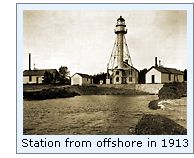 Contracts for the iron work and
building materials for the new station were awarded in 1861, and a work
crew dispatched to the island with the materials that summer. The tower
was built of prefabricated numbered cast iron sections which were
assembled in a manner similar to that of a giant erector set. The tower
featured a six-foot diameter cylindrical cast iron center cylinder of ¼
inch plates, with its interior wall lined with wood paneling to help
reduce condensation. Within this cylinder, a series of cast iron stairs
spiraled from the entry at the lower end to the lantern, which was also
fabricated of cast iron sections. The center cylinder and lantern were
supported by four tubular iron legs which were bolted to concrete
foundation pads. The four legs were in turn supported by horizontal
cross members with the entire assembly provided rigidity by way of
diagonal iron braces equipped with turnbuckles. Interestingly, the
central cylinder did not reach the ground, but was suspended
approximately 17 feet above ground level, with entrance gained from the
second floor of the two story wood frame dwelling through an elevated
covered passageway. Construction of the new station continued through
the arrival of winter in 1861, and then resumed with the opening of the
navigation. Contracts for the iron work and
building materials for the new station were awarded in 1861, and a work
crew dispatched to the island with the materials that summer. The tower
was built of prefabricated numbered cast iron sections which were
assembled in a manner similar to that of a giant erector set. The tower
featured a six-foot diameter cylindrical cast iron center cylinder of ¼
inch plates, with its interior wall lined with wood paneling to help
reduce condensation. Within this cylinder, a series of cast iron stairs
spiraled from the entry at the lower end to the lantern, which was also
fabricated of cast iron sections. The center cylinder and lantern were
supported by four tubular iron legs which were bolted to concrete
foundation pads. The four legs were in turn supported by horizontal
cross members with the entire assembly provided rigidity by way of
diagonal iron braces equipped with turnbuckles. Interestingly, the
central cylinder did not reach the ground, but was suspended
approximately 17 feet above ground level, with entrance gained from the
second floor of the two story wood frame dwelling through an elevated
covered passageway. Construction of the new station continued through
the arrival of winter in 1861, and then resumed with the opening of the
navigation.
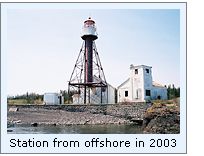 On the station's completion in 1862,
the importance the Lighthouse Board placed on the station was witnessed
by the fact that the new lantern was outfitted with a large Third Order
Fresnel lens manufactured by Henry-Lepaute, an order of which only
nineteen would ever be displayed in all of the western Great Lakes
lights. The lens featured six bulls-eye flash panels, which when rotated
around the lamp would provide the station's designated characteristic of
a solid white light punctuated by intense white flashes once every
minute. With the station's completion, the old tower and dwelling were
in such poor condition that they were razed, being considered as unfit
for modification for alternate use. On the station's completion in 1862,
the importance the Lighthouse Board placed on the station was witnessed
by the fact that the new lantern was outfitted with a large Third Order
Fresnel lens manufactured by Henry-Lepaute, an order of which only
nineteen would ever be displayed in all of the western Great Lakes
lights. The lens featured six bulls-eye flash panels, which when rotated
around the lamp would provide the station's designated characteristic of
a solid white light punctuated by intense white flashes once every
minute. With the station's completion, the old tower and dwelling were
in such poor condition that they were razed, being considered as unfit
for modification for alternate use.
 With the exception of the arrival of a
work crew to repair a crack in the iron band at the base of the main
tower cylinder and to repaint the entire station two years previous,
life on Manitou in 1870 was largely one of quiet isolation for Keeper
Charles Corgan and his brother Henry, who was serving as his assistant,
and it is quite likely that they were oblivious to plans being discussed
in Detroit and Washington that would forever change the sanctity of
their remote island station For it was in 1870 that the Lighthouse Board
recommended to Congress that funds be appropriated for the establishment
of a fog signal on the island to help guide mariners making the turn in
the pea soup fogs which frequently blanketed the area. Congress
responded quickly, appropriating $5,000 for the fog signal's
construction on March 3, 1871. With the exception of the arrival of a
work crew to repair a crack in the iron band at the base of the main
tower cylinder and to repaint the entire station two years previous,
life on Manitou in 1870 was largely one of quiet isolation for Keeper
Charles Corgan and his brother Henry, who was serving as his assistant,
and it is quite likely that they were oblivious to plans being discussed
in Detroit and Washington that would forever change the sanctity of
their remote island station For it was in 1870 that the Lighthouse Board
recommended to Congress that funds be appropriated for the establishment
of a fog signal on the island to help guide mariners making the turn in
the pea soup fogs which frequently blanketed the area. Congress
responded quickly, appropriating $5,000 for the fog signal's
construction on March 3, 1871.
 A pair of wood frame fog signal buildings
were erected on each side of the tower in 1875, with their interior walls lined with sheet iron for fire
protection, and on completion, each building was outfitted with its own steam
engine supplying steam to a 10-inch locomotive whistles. A pair of wood frame fog signal buildings
were erected on each side of the tower in 1875, with their interior walls lined with sheet iron for fire
protection, and on completion, each building was outfitted with its own steam
engine supplying steam to a 10-inch locomotive whistles.
According to Lighthouse Board policy,
station log books were supposed to contain concise single-line entries
reporting the weather conditions and notable happenings at the station,
with "no personal opinions or remarks on family affairs or ordinary
household work." However, James Corgan, who served as Keeper of the
Manitou Light from October 22, 1873 through July 29, 1875 was a strong-willed
individual, who took great pride in his abilities and intelligence. Not
one to suffer bureaucratic nonsense well, Corgan was surprisingly
forthright in his log entries. On August 5, 1875, Corgan visited L'Anse, where he
learned of the Board's impending decision to remove him from his
position. Click here to view
excerpts of the Manitou station log book.
Over the ensuing years, the Manitou fog signals proved to be one of the
most active in the district, and by the late 1880's it was determined
that the apparatus in both buildings had outlived their useful lives. The lighthouse tender
AMARANTH arrived at the station with a work party and the necessary
supplies for construction in late May of 1899. The north fog signal building
was extended 12 feet to an overall length of 42 feet in order to make
room for both sets of apparatus, and a new concrete
floor poured throughout. After removal of the worn out apparatus, the
new machinery was installed and tested. With the construction of a 12
foot by 17 foot coal bin, construction was completed on July 3, and the
AMARANTH returned to remove the work party to transport them to their
next work assignment.
 It would appear that there were some
significant personnel problems encountered at the station in 1881, since
Keeper Henry Guilbault and his 2nd assistant Richard Rickard were both
simultaneously removed from their positions on October 22, 1881, leaving
Guibault's brother Norman, the station's 1st Assistant temporarily in
charge. Reuben Hart, who had been serving at Huron Island for the past
two years was promoted as Acting Keeper of the Manitou Light. On Hart's
arrival at Manitou on October 26, Guilbault was simultaneously
transferred to Huron Island to fill the opening left by Hart's
promotion. Hart appears to have manned the station single-handedly
through the end of the 1881 navigation season. It would appear that there were some
significant personnel problems encountered at the station in 1881, since
Keeper Henry Guilbault and his 2nd assistant Richard Rickard were both
simultaneously removed from their positions on October 22, 1881, leaving
Guibault's brother Norman, the station's 1st Assistant temporarily in
charge. Reuben Hart, who had been serving at Huron Island for the past
two years was promoted as Acting Keeper of the Manitou Light. On Hart's
arrival at Manitou on October 26, Guilbault was simultaneously
transferred to Huron Island to fill the opening left by Hart's
promotion. Hart appears to have manned the station single-handedly
through the end of the 1881 navigation season.
On March 29, 1882, Henry Ferguson and
John Gustafson arrived on Manitou, freshly hired to fill the positions
of 1st and 2nd Assistant Keepers, respectively. Evidently neither
Ferguson nor Gustafson were cut from the right cloth for lighthouse
service, and hiring the two men proved to be a mortal error for Hart. A
scant few months later, the two men would stand by as they watched
Hart's boat overturn a few feet off the island with neither of them
lifting a finger to render assistance.
In a strange twist of fate, James
Corgan who had been re-hired into lighthouse service as keeper of the
Gull Rock Light was the first outsider to come to Manitou after the
incident and helped search for the body. Instructed to temporarily
assume responsibility for Manitou until a new Keeper could be assigned,
Corgan recounted the story in detail in the Manitou log book. Click
here to read Corgan's full account directly from the Manitou
log.
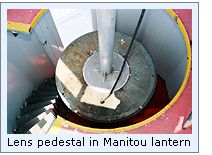 As part of a system-wide upgrade, a
brick oil storage house was built in 1895, and the fog signal apparatus
was thoroughly overhauled. Two years later, a sixty foot long dock was
constructed of huge timber cribs filled with stone. Amazingly, these
massive cribs were pulverized during a violent gale in October 1898, and
a work crew was dispatched to the island to undertake temporary repairs
late that season. While on site, the crew also began blasting the rocky
shore to prepare for the construction of a boat house and boat ways.
While the tender AMARANTH delivered a hoisting engine for the station
and materials for the construction of more permanent cribs and a derrick
in 1900, it was not until 1901, that a work crew was placed on the
island to complete construction of the boathouse, boat ways, dock and
derrick, and to repaint the tower, changing its color from brown to
white. As part of a system-wide upgrade, a
brick oil storage house was built in 1895, and the fog signal apparatus
was thoroughly overhauled. Two years later, a sixty foot long dock was
constructed of huge timber cribs filled with stone. Amazingly, these
massive cribs were pulverized during a violent gale in October 1898, and
a work crew was dispatched to the island to undertake temporary repairs
late that season. While on site, the crew also began blasting the rocky
shore to prepare for the construction of a boat house and boat ways.
While the tender AMARANTH delivered a hoisting engine for the station
and materials for the construction of more permanent cribs and a derrick
in 1900, it was not until 1901, that a work crew was placed on the
island to complete construction of the boathouse, boat ways, dock and
derrick, and to repaint the tower, changing its color from brown to
white.
1907 saw the installation of 80
concrete sidewalk slabs which had been pre-cast at the Detroit depot and
the installation of a steel water supply tank for the fog signals. This
was also a memorable year for the Manitou Keepers, as they hauled and
shoveled 40 tons of coal during the season to keep the fog signals
screaming for a station-high 627 hours.
In order to increase the range of
visibility of the light, the lamp was changed from kerosene to
incandescent oil vapor on June 30, 1913, with an impressive increase in
output from 15,000 to 220,000 candlepower. At this time, the
characteristic of the light was also changed to flashing white every 10
seconds
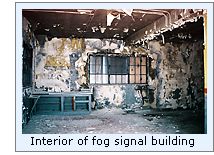 With the growing maritime adoption of
radio technology, a radio beacon was installed at the station on October
23, 1925. Emitting a repeated characteristic of sixty-second blasts of
three Morse Code dashes followed by a ninety second silence, the beacon
was activated during periods of thick weather and for a half hour each
morning and afternoon for testing purposes. 1928 saw the electrification
of the Light and dwelling through the installation of diesel powered
generator and battery system. Under the Works Project Administration,
the fog signal was completely rebuilt in 1930, and the steam whistles
replaced by a pair of compressor-powered Type F
diaphones. Also around this time, an underwater telephone line
was laid from Keweenaw Point to the station, truly bringing the
twentieth century to the island. With the growing maritime adoption of
radio technology, a radio beacon was installed at the station on October
23, 1925. Emitting a repeated characteristic of sixty-second blasts of
three Morse Code dashes followed by a ninety second silence, the beacon
was activated during periods of thick weather and for a half hour each
morning and afternoon for testing purposes. 1928 saw the electrification
of the Light and dwelling through the installation of diesel powered
generator and battery system. Under the Works Project Administration,
the fog signal was completely rebuilt in 1930, and the steam whistles
replaced by a pair of compressor-powered Type F
diaphones. Also around this time, an underwater telephone line
was laid from Keweenaw Point to the station, truly bringing the
twentieth century to the island.
Today, Manitou station still serves as
a guide to mariners, it's light currently provided by a 12-volt solar
powered 190 mm acrylic, displayed from the same position in the lantern
from which the mighty Third Order Fresnel once stood. As of this date,
we have been unable to identify the disposition of the Fresnel, and
would appreciate hearing from anyone who might know of its whereabouts
that at least in the words on this page we might reunite it with its
station.

Keepers of
this Light

Click here to
see a complete listing of all Manitou Island Light keepers compiled by
Phyllis L. Tag of Great Lakes Lighthouse Research.

Seeing this Light

We have yet to visit this light, but
will update with our observations as soon as we arrange to make landfall
on the island.

Finding this
Light

Keweenaw Excursions offers various lighthouse cruises on board the
KEWEENAW STAR out of Houghton, Michigan. A number of these tours include
close passes by the Gull Rock Light. For more information on any of
their tours visit their website,
or telephone Keweenaw Excursions at (906) 482-0884.

Reference Sources

Annual report of the Fifth Auditor of the Treasury, 1850
Annual reports of the Lighthouse Board, various, 1853 through
1909.
Annual reports of the Lighthouse Service, various, 1910 through
1939.
Annual reports of the Lake Carrier's Association, 1939 through
1950
Great Lakes Light Lists, 1861. 1872. 1901, 1928, 1939.
US Lake Survey Great Lakes Pilot, 1958.
Keeper listings for Michigan Island Light appears
courtesy of Great
Lakes Lighthouse Research
|
